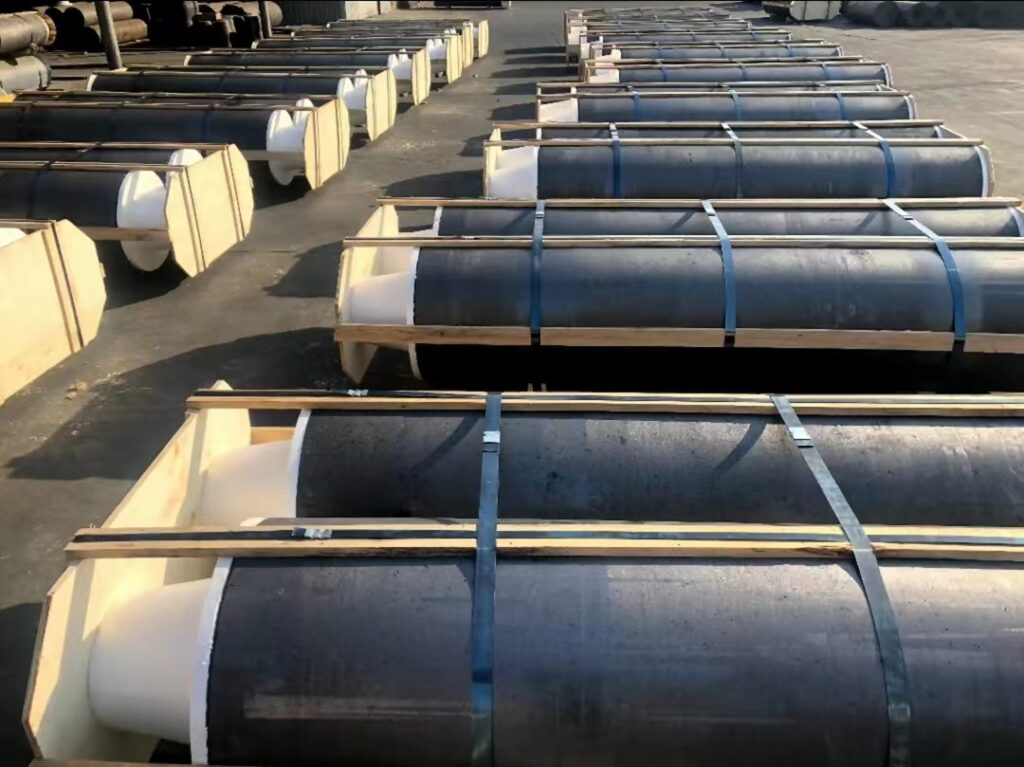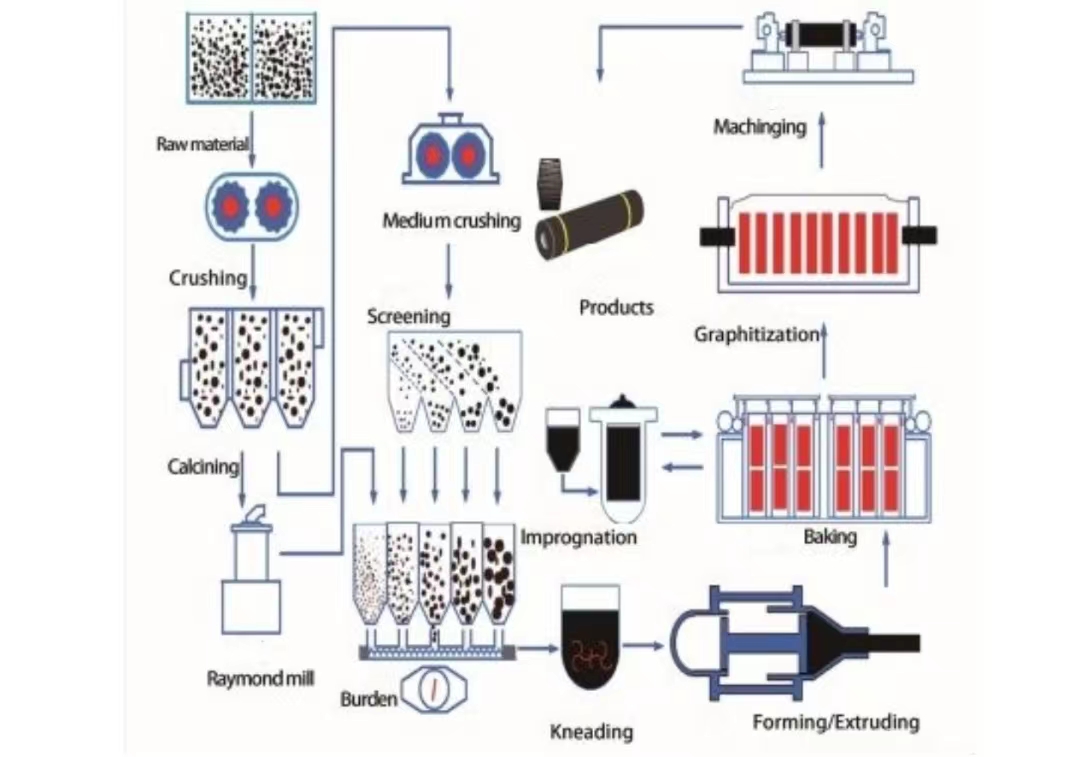Los electrodos de grafito, fabricados con coque de petróleo y coque de aguja de alta calidad, son una parte vital de la industria moderna. Pero, ¿qué es exactamente y cuál es su función en diversos procesos industriales?
Índice
ToggleEn este blog, profundizaremos en los usos y propiedades de los electrodos de grafito, proporcionando una visión completa de este componente esencial.
Electrodos de grafito
En el fondo, un electrodo de grafito es un componente resistente a altas temperaturas y altamente conductor que se utiliza principalmente en hornos de arco eléctrico (EAF) para la fabricación de acero y otras aplicaciones metalúrgicas e industriales. También existen hornos de afino de cuchara y hornos de arco sumergido.
Las propiedades térmicas superiores del grafito, su excelente conductividad eléctrica y su estabilidad estructural incluso a altas temperaturas los hacen indispensables.
El papel de los electrodos de grafito en la siderurgia por arco voltaico
La siderurgia es uno de los principales sectores en los que entran en juego los electrodos de grafito. Los hornos de arco eléctrico los utilizan para fundir chatarra de acero. Los electrodos crean un arco eléctrico con una temperatura extremadamente alta de 3000°C que funde la chatarra, lo que permite reciclarla en acero nuevo.
En este proceso, sirven como material conductor, permitiendo que una carga pase a través del horno y genere el calor necesario. Su capacidad para resistir y funcionar eficazmente a estas altas temperaturas es la base de su papel crucial en los hornos de arco eléctrico. siderurgia.
Otras aplicaciones
Además de la siderurgia, electrodos de grafito se utilizan en otros sectores:
Fundición de minerales metálicos: Buen conductor resistente a altas temperaturas utilizado en hornos de arco eléctrico. Cuando se energiza, se genera un arco y se libera una gran cantidad de calor para la fundición.
Industria química:Se utilizan en la producción de cloro y sosa cáustica por electrólisis de salmuera, así como en procesos de química fina.
Industria de semiconductores: Se utilizan en la fundición de materiales básicos como el silicio monocristalino y el silicio policristalino.
Industria energética: Utilizado en la fabricación de baterías, especialmente materiales de electrodos negativos para baterías de litiopara aprovechar al máximo su resistencia a las altas temperaturas y sus propiedades conductoras.
Propiedades
Conductividad eléctrica: Se eligen por su conductividad eléctrica superior, que permite un paso eficaz de la corriente eléctrica a través del horno.
Resistencia térmica: Soportar altas temperaturas es vital en aplicaciones como los hornos de arco eléctrico. Ofrecen una excelente resistencia térmica, manteniendo su estructura incluso bajo un calor intenso.
Resistencia mecánica: A pesar de las altas temperaturas, debe mantener su integridad estructural. Su elevada resistencia mecánica garantiza que no se rompan ni se deformen en condiciones operativas.
Bajo coeficiente de expansión térmica: Un coeficiente de dilatación térmica bajo significa que el electrodo no se dilata mucho cuando se calienta. Esta propiedad evita que el electrodo se agriete o se rompa debido a los rápidos cambios de temperatura en el horno.
Proceso de fabricación
El proceso de fabricación de electrodos de grafito es un procedimiento de varios pasos que comienza con la obtención de materias primas, principalmente petróleo y coca de aguja.
A continuación, los materiales se pulverizan y se mezclan con brea de alquitrán de hulla como aglutinante. A continuación, esta mezcla se moldea en forma de electrodos y se hornea a altas temperaturas.
Por último, se grafitizan calentándolas a una temperatura superior a 3.000 °C y, a continuación, se mecanizan con dimensiones específicas.
Impactos de la dinámica del mercado de electrodos de grafito
Merece la pena mencionar que la dinámica de la oferta y la demanda de los mismos repercute significativamente en las industrias mundiales. Dado que estos electrodos forman parte integrante de los producción de aceroLas interrupciones en su suministro pueden dificultar la producción de acero.
Por otra parte, un aumento de la producción de acero debido a los crecientes proyectos de infraestructuras puede disparar la demanda y, por consiguiente, el precio de electrodos de grafito.
Sostenibilidad
Ahora que el mundo se centra cada vez más en la sostenibilidad, el papel de los electrodos de grafito es cada vez más importante.
La fabricación de acero en horno de arco eléctrico es más respetuosa con el medio ambiente que los altos hornos tradicionales, ya que permite reciclar la chatarra.
Por tanto, su papel integral en los hornos de arco eléctrico los sitúa en el centro de la siderurgia sostenible.
Perspectivas de futuro
El futuro de los electrodos de grafito parece prometedor. Se espera que su demanda aumente con el cambio de las industrias mundiales hacia prácticas más eficientes desde el punto de vista energético.
Además, es probable que los avances en la ciencia de los materiales conduzcan al desarrollo de productos aún más eficientes y duraderos.
En conclusión
Los electrodos de grafito son cruciales en la industria moderna, desde la siderurgia hasta la producción de aluminio. Su excepcional resistencia térmica, excelente conductividad eléctrica, alta resistencia mecánica y baja dilatación térmica los convierten en piezas clave en estos exigentes entornos.
A medida que aumente la fabricación de acero en hornos de arco eléctrico y los procesos de fabricación respetuosos con el medio ambiente, su uso irá en aumento. Por lo tanto, comprender su uso y rendimiento es vital para cualquiera que participe en estas industrias.



